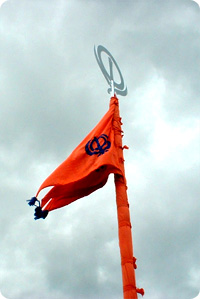Sikh Emblems
KHANDA
 The symbol of different religions reflect certain fundamental concepts of the faith. The symbol in Sikh religion derives its name from the double edged sword – The Khanda – at the heart of the logo. The Khanda is a potent metaphor of divine knowledge, its sharp edges cleaving truth from false hood.
The symbol of different religions reflect certain fundamental concepts of the faith. The symbol in Sikh religion derives its name from the double edged sword – The Khanda – at the heart of the logo. The Khanda is a potent metaphor of divine knowledge, its sharp edges cleaving truth from false hood.
The circle around the Khanda is the Chakar – a figure without beginning or end – symbolising an infinite God. Infinite God resides in His Creation, the world. The Sikh is to seek divine knowledge as the path to ultimate Union with God, a state as complete and perfect as the circle.
The two Kirpans that flak the Chakar symbolise the twin concept of Miri and Piri – temporal and spiritual responsibility. They occupy a central place in Sikh theology which places equal emphasis on the spiritual aspiration of the individual to serve the society.
The twin Kirpans in the logo thus represent the balance between personal spiritual salvation and the obligation to serve others.
Individual action is to be governed by Godliness; at the same time, the practice of religion must resolve around service to the poor, oppressed and the disadvantaged.
The Kirpan is also worn on the person at all times, as an article of faith, by the Sikhs who aspire to meet the discipline of the Khalsa order. It is not a weapon. It serves as a reminder to all Sikhs of the duty to serve the needs of others, before their own.
THE NISHAN SAHIB
 It is made of cotton or silk cloth, saffron in colour and triangular in shape and is another name for the flag of Sikh nation that symbolises sovereignty.
It is made of cotton or silk cloth, saffron in colour and triangular in shape and is another name for the flag of Sikh nation that symbolises sovereignty.
The Nishan Sahib, that is in vogue today, is supported by a pole of timber or metal having Khanda – a double edged sword fixed at its top.
It also has a Khanda emblem put on the saffron cloth.
This Nishan Sahib, as a matter of religious injunction, must hoist at each every building of the Gurdwara. It is this Nishan Sahib that is referred to in the daily prayer (Ardas) of the Sikhs asking for immortality.